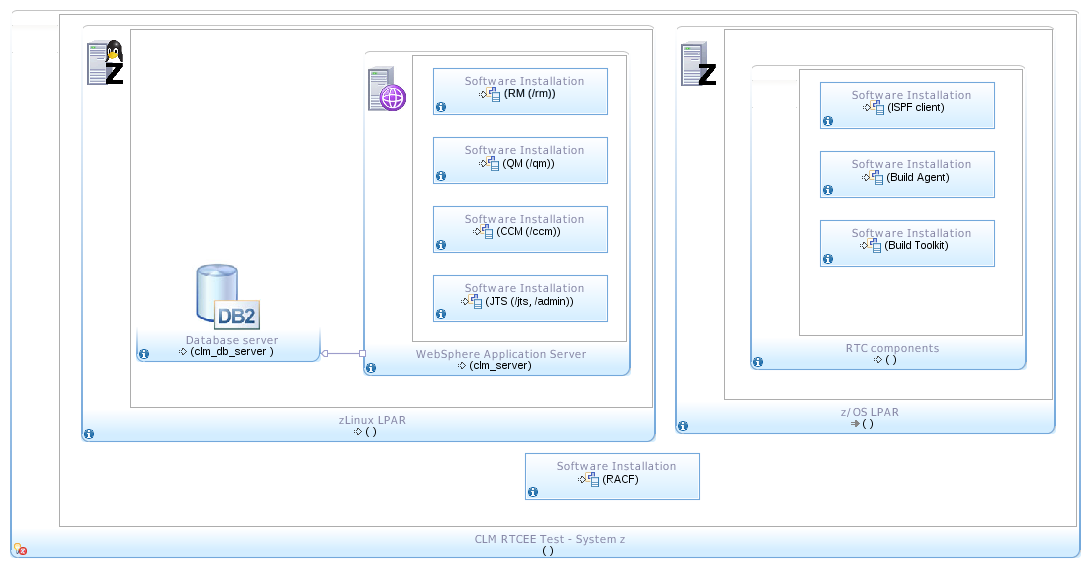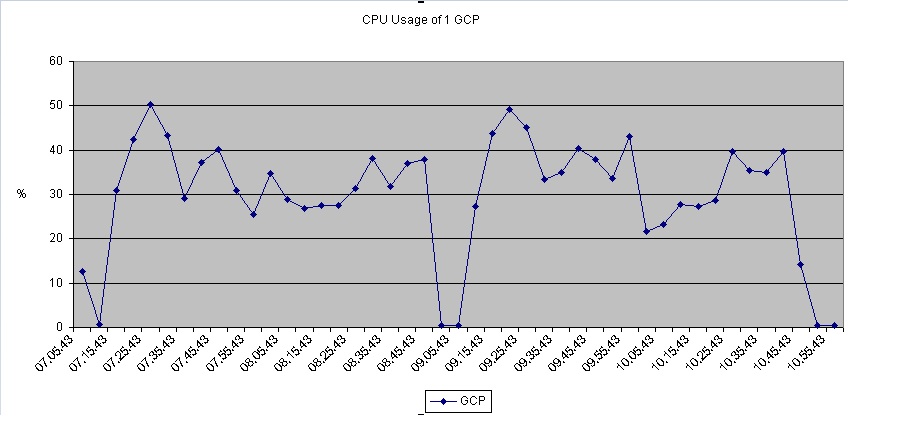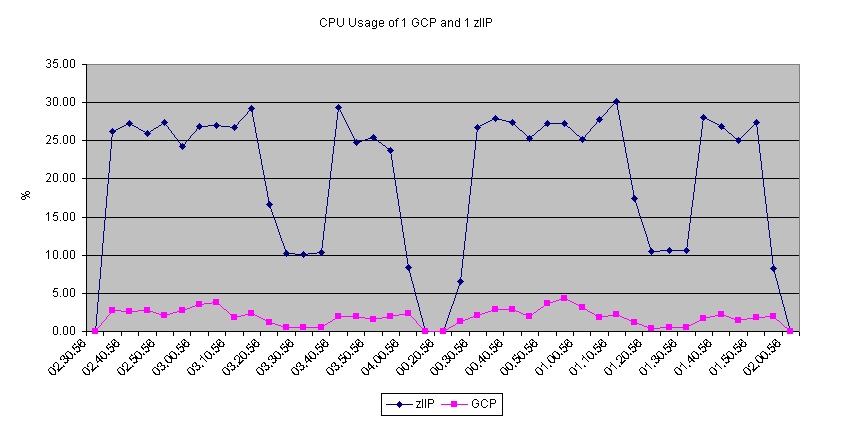 Rational Team Concert Enterprise Extension zIIP Offload Performance in 5.0 Sprint 4
Rational Team Concert Enterprise Extension zIIP Offload Performance in 5.0 Sprint 4
Authors: Lu Lu Last updated: May 6, 2014
Build basis: Rational Team Concert on zOS, version: 5.0 Sprint 4
Introduction
This report provide the offload percentage of Java workload in RTC EE by System z Integrated Information Processor (zIIP).
zIIP processor can help to offload application workload(Java application) from z/OS greatly.
Objective of this testing is to provide offload percentage of Java workload in RTC EE by zIIP processor.
Note: We strongly recommend to run with a zIIP or zAAP on the build machine in order to offload the java workload and make it less expensive.
Disclaimer
The information in this document is distributed AS IS. The use of this information or the implementation of any of these techniques is a customer responsibility and depends on the customer’s ability to evaluate and integrate them into the customer’s operational environment. While each item may have been reviewed by IBM for accuracy in a specific situation, there is no guarantee that the same or similar results will be obtained elsewhere. Customers attempting to adapt these techniques to their own environments do so at their own risk. Any pointers in this publication to external Web sites are provided for convenience only and do not in any manner serve as an endorsement of these Web sites. Any performance data contained in this document was determined in a controlled environment, and therefore, the results that may be obtained in other operating environments may vary significantly. Users of this document should verify the applicable data for their specific environment.
Performance is based on measurements and projections using standard IBM benchmarks in a controlled environment. The actual throughput or performance that any user will experience will vary depending upon many factors, including considerations such as the amount of multi-programming in the user’s job stream, the I/O configuration, the storage configuration, and the workload processed. Therefore, no assurance can be given that an individual user will achieve results similar to those stated here.
This testing was done as a way to compare and characterize the differences in performance between different versions of the product. The results shown here should thus be looked at as a comparison of the contrasting performance between different versions, and not as an absolute benchmark of performance.
What our tests measure
We use predominantly automated tooling such as Rational Performance Tester (RPT) to simulate a workload normally generated by client software such as the Eclipse client or web browsers. All response times listed are those measured by our automated tooling and not a client.
The diagram below describes at a very high level which aspects of the entire end-to-end experience (human end-user to server and back again) that our performance tests simulate. The tests described in this article simulate a segment of the end-to-end transaction as indicated in the middle of the diagram. Performance tests are server-side and capture response times for this segment of the transaction.

Findings
In this scenario, we compare CPU utilization between 1 general CP and 1 general CP with 1 zIIP processor to find that offload percentage of Java workload in RTC EE on the build machine when using zIIP processor.* From zIIP performance testing result, we find that about 80% - 90% workload has been offloaded by zIIP processor and CPU utilization of general CP is blow 5% utilization smooth and steady with zIIP processor.
The IBM System z Integrated Information Processor (zIIP) is available on all IBM zEnterprise (zEnterprise), System z12, System z10, and System z9 servers. It is designed to increase general computing capacity and to lower overall total cost of computing for select data and transaction processing workloads for business intelligence (BI), ERP and CRM, and select network encryption workloads on the mainframe.
Topology
The tests are executed in a Single Tier Topology infrastructure like the one in the following diagram:

The RTC server was set up based on WebSphere and DB2 on Linux for System z. The build machine with Rational Build Agent was on zOS.
| Test Environment | ||
|---|---|---|
| RTC Server | Operating System & Version: Linux for System z (SUSE Linux Enterprise Server 10 (s390x)) System Resource : 10 GB Storage, 4 CPs (20000 mips, CPU type : 2097.710, CPU model: E12) CLM: 5.0 Sprint4 (CALM-I20131211-0734), 4 GB heap size DB2: 9.7.0.5 WAS: 8.5.5.1 |
|
| Build Forge Agent | Operating System & Version: z/OS 01.12.00 System Resource: 6 GB Storage, 4 CPs (20000 mips, CPU type : 2097.710, CPU model: E12) Build System Toolkit: 5.0 Sprint4 (RTC-I20131211-0354) |
Methodology
Monitor tools - NMON is used for RTC server and RMF on zOS was used for Rational Build Agent.The sample project for the test was Mortgage*1000 which is 1000 duplicates of the Mortgage sample application .
| Test Data | |
|---|---|
| Sample Project | Mortgage*1000 |
| Assets | 6000 COBOL programs 4000 Copybooks 2000 BMS 3 others |
| Total Assets | 12003 |
In the repository, source code is stored in one stream with one single component which includes 5 zComponent Projects.
Each test scenario is executed twice against for comparation.
Test Scenarios
| Test Scenario | Description |
|---|---|
| Full Dependency Build | 1. Run 2 time of full dependency build with 1 general CP; 2. Run 2 time of full dependency build with 1 general CP and 1 zIIP |
Results
Run duration
These data tables show the run duration comparing between 1 general CP and 1 general CP + 1 zIIP with the test start and completion time.
From testing result of build time, we can find that Full Dependency build takes a little less time when zIIP online, saved about 10% build time.

CPU and Memory for Build Agent
|
This graph shows CPU utilization for Build Forge Agent on ZOS machine, data is collected by RMF tool.
About 80% - 90% java workload has been offloaded by zIIP processor. |
| With one general CP: |
 |
| With one general CP & one zIIP: |

|
Appendix A - Key Tuning Parameters
| Product |
Version | Highlights for configurations under test |
|---|---|---|
| IBM WebSphere Application Server | 8.5.5.1 | JVM settings:
* GC policy and arguments, max and init heap sizes:
-Xmn512m -Xgcpolicy:gencon -Xcompressedrefs -Xgc:preferredHeapBase=0x100000000 -Xmx4g -Xms4gOS configuration: * hard nofile 120000 * soft nofile 120000Refer to http://pic.dhe.ibm.com/infocenter/clmhelp/v4r0m4/topic/com.ibm.jazz.install.doc/topics/c_special_considerations_linux.html for details |
| DB2 | DB2 Enterprise Server 9.7.0.5 | Tablespace is stored on the same machine as IBM WebSphere Application Server |
| License Server | Same as CLM version | Hosted locally by JTS server |
| Network | Shared subnet within test lab |
Appendix A - Reference materials
| Refer to following links for zIIP processor material: |
| - http://www-03.ibm.com/systems/z/hardware/features/ziip/capability.html - http://www-03.ibm.com/systems/z/hardware/features/ziip/index.html |
About the authors
Questions and comments:
- What other performance information would you like to see here?
- Do you have performance scenarios to share?
- Do you have scenarios that are not addressed in documentation?
- Where are you having problems in performance?
Warning: Can't find topic Deployment.PerformanceDatasheetReaderComments
-
 Deployment web
Deployment web
-
 Planning and design
Planning and design
-
 Installing and upgrading
Installing and upgrading
-
 Migrating and evolving
Migrating and evolving
-
 Integrating
Integrating
-
 Administering
Administering
-
 Monitoring
Monitoring
-
 Troubleshooting
Troubleshooting
Status icon key:
-
 To do
To do
-
 Under construction
Under construction
-
 New
New
-
 Updated
Updated
-
 Constant change
Constant change
- None - stable page
- Smaller versions of status icons for inline text:
-





Contributions are governed by our Terms of Use. Please read the following disclaimer.
Dashboards and work items are no longer publicly available, so some links may be invalid. We now provide similar information through other means. Learn more here.